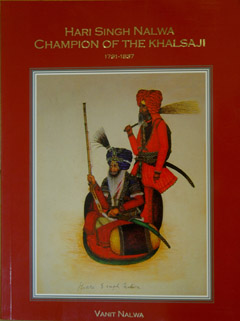Great General and able administrator
Amrik Singh
Hari Singh Nalwa: Champion of the Khalsaji
by Vanit Nalwa.
Manohar.
Pages 367. Rs 1,295.
The Sunday Tribune, May 31, 2009
IT is perfectly understandable that Ranjit Singh’s life and achievement have received considerable scholarly attention. His role in Punjab history and achievements fully justify that. However, the man who chiefly assisted Ranjit Singh in expanding and consolidating his empire was his legendry general Hari Singh Nalwa. Some half a dozen books have been written about him but there is not one single volume which can be described as standard. It was left to one of his descendants to write one. Unless one is mistaken, for the next couple of decades, this book is likely to be accepted not only as the most detailed and factual account of what he did and achieved, it is also likely to be quoted as the most authoritative one on the subject.
 The interesting thing about the author is that she is not an historian by training and is a professional psychologist. She taught for a few years at one of the Delhi colleges, but gave up that job and became a consultant for which job she had been trained both in India and abroad. For the last few years, however, she has been engaged in writing this book. It must be said to her credit that no professional historian could have done better than what she has done.
The interesting thing about the author is that she is not an historian by training and is a professional psychologist. She taught for a few years at one of the Delhi colleges, but gave up that job and became a consultant for which job she had been trained both in India and abroad. For the last few years, however, she has been engaged in writing this book. It must be said to her credit that no professional historian could have done better than what she has done.
The book gives a detailed account of Nalwa’s early years, his encounter with a tiger that Nalwa killed with his small dagger, his induction into Maharaja’s army, his participation in the battle of Kasur, his appointment as the Commander of the Lahore Army and such other matters.
The third chapter entitled "Sikhs and Afghans: 1813-1819" gives a preview of how his career was shaped. He was appointed Governor of Kashmir in 1820 but meanwhile he also took part in the conflict over Hazara which eventually proved to be a major undertaking. Among other things, he also established a new township which was eventually named after him.
The years 1822 to 1831 describe him as the "Viceroy: on the Western Frontier" after which he was recognized as a leading political figure who also participated in diplomatic negotiations with the British.
In this connection, two things need to be noted. One was the fact that after it had been agreed between Ranjit Singh and the East India Company that the frontier between the two powers would be the river Sutlej, the issue now was how Ranjit Singh’s kingdom was to be expanded, if at all. It was here that Nalwa played a sterling role. After the conflicts of Hazara and Kashmir, the only way Ranjit Singh could expand was to conquer the Pathans and that is where Nalwa played a decisive role. This was his second important contribution to policy making.
Without going into details one thing needs to be widely acknowledged. Nalwa conquered and controlled the Pathans in such a manner that he became a legend in his own lifetime. The author says towards the end of the book: "In the two-and-a-half centuries that Afghanistan has existed as a nation, three ‘super powers’ — Britain, Russia and the United States of America— have attempted to subdue the Afghans with little, or absolutely no success. The Sikhs won the only real victories against them and Hari Singh Nalwa’s success has remained unmatched."
This statement more or less sums up the approach adopted by the author in her book. To what extent this statement is applicable to today’s situation is a matter of personal opinion and judgment.
One thing that the author brings out in considerable detail is that Nalwa was both a fighter and an administrator. The way he administered both Hazara and Kashmir has been described in detail. She goes beyond that and has written a separate chapter on "Towns, Forts, Gardens and Shrines". Having done that, she has done, two additional chapters —"The Legend" and "Champion of the Khalsaji". The only thing one can say about these two chapters is that it would have been better to have made them a little more concise that what has been done. There are no misstatements, but the pride of the author in her distinguished ancestor comes through without any disguise. It does not unbalance the book, but comes close to that. Perhaps that is putting it too strongly, but while reading it one cannot get away from the feeling that a little more economy of words would have been preferable.
The real problem of the book is its size and price. The whole book is printed on art paper. It lavishly illustrated and makes a lively impression on the readers. In the process however, two things happen. The book weights almost a kilo and is therefore difficult to handle. Secondly, the price becomes unavoidably high. Since this book is likely to also become the authoritative biography of Nalwa it is bound to be used by students. It is for consideration how to bring out a cheaper edition and thereby make it more easily accessible to the average reader.
It is an important book from every point of view and is likely to hold ground for the next few decades.